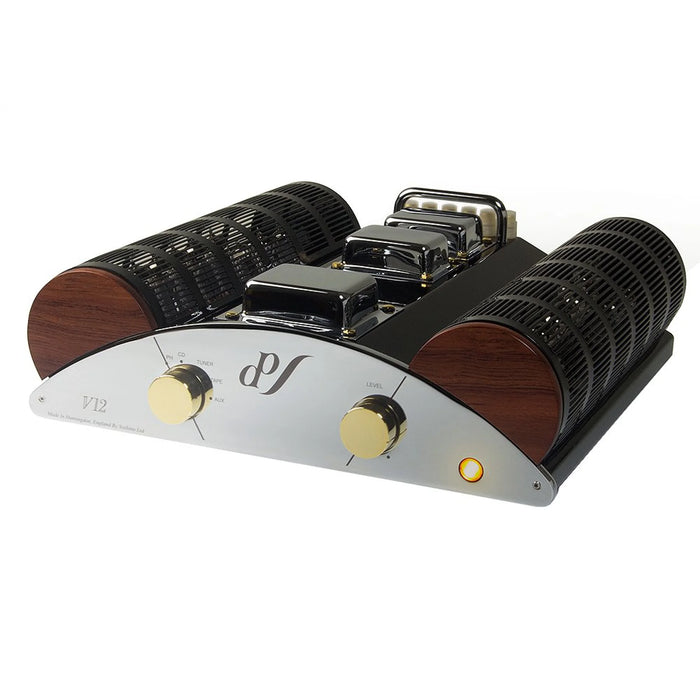
EAR Yoshino V12 Audiophile Integrated Tube Amplifier
Taxes & Shipping Included
Referenced from Tim de Paravicini’s admiration of Jaguar’s powerplant, the EAR V12 extracts much of the same philosophy. The design utilises six EL84s on each bank for a total of twelve, the sum of which is high performance with balance and grace.
The geometry isn’t just engine mimicry but allows for an organised and compact layout with central weight distribution. This creates a design that has powerful lines and compelling proportions. Despite its bold use of chrome and adventurous styling, the EAR V12 sits proud but is not obtrusive in any environment.
The V12 utilises EAR Yoshino’s rich tradition of workmanship, blending high calibre engineering with craft. Beautiful hand selected and polished wooden end caps on the ‘half moon’ valve covers add a simple but distinctive touch to the design making each EAR V12 unique. Chrome transformer covers suggesting a sleek aerodynamic power block, with sufficient power in reserve for the most demanding audio terrain.
Breathtaking from every angle, the EAR V12 is built with a level of quality associated with solid construction that gives the impression that you are using something truly special.
Tim de Paravicini’s vision was beyond just a collection of EL84s but to create an amplifier of unparalleled power and clarity. Utilizing Tim’s own ‘balanced bridge mode circuit’ that takes the primary windings of the output transformer and splits them equally between the Anode and Cathode circuits of the tubes so they’re capacitively cross-coupled enabling increased bandwidth.
Aided with the use of a Pentode Mode parallel push-pull class “A” circuit, the valve amplifier produces soft second harmonic distortion in low quantities with superb linearity.
The transformers are bespoke designs, that are hand-wound in Cambridgshire, England. The output transformers are designed and built for ultra-wide bandwidth. Providing extended frequency response at both ends of the spectrum.
Each bank of six EL84’s provids fifty watts of pure high quality audio and improved low-level detail. With perfect loudspeaker coupling, the V12 is equipped with the smooth muscular power of its automotive namesake. As a consequence of Tim de Paravicini’s attention to detail in the design process, he ensured that this power is conservatively within the capability of the V12.
Features
- 50 Watts/Channel
- Twelve EL84 (6BQ5) Valves
- Ten ECC83 (12AX7) Valves
- Five Analogue inputs (RCA)
- Chrome Facia with gold or chrome knobs
- Made in England
Specifications
- Valves Twelve EL84 (6BQ5)Ten ECC83 (12AX7)
- Frequency Response 12-60Khz -3dB
- Signal-to-noise Ratio 93dB
- Input Sensitvity 0.4V
- Input Impedance 47kΩ
- Output Damping Factor 10
- Inputs Five Line Inputs (RCA)
- Outputs One Tape Output (RCA)
- Power Output (20-20KHz): 50W into 4 & 8Ω (8 & 16Ω optional)
- Total Harmonic Distortion <0.03%
- Weight 22kg (48lb)
- Length 420 mm (16.5”)
- Width 440 mm (17.3”)
- Height 135mm (5.3”)
- Power Consumption 200 watts 240 volt
About EAR
EAR (formerly “Esoteric Audio Research”) is the brainchild of Tim de Paravicini, whose name has been associated since the 1970s with electronics of the highest fidelity. De Paravicini’s innovative techniques have not only borne fruit in products for EAR but in designs for some of the world’s most highly regarded electronics manufacturers. Some of these designs have been continually prized—and sought—by discerning listeners for decades after their introduction.
Tim de Paravicini has also made unique contributions to the world of professional recording and mastering. Users of his tape recording systems, microphones, and other recording technology include performers Pink Floyd and Lenny Kravitz, the Altarus and Water Lily record labels, and renowned recording and mastering engineers like Robert Ludwig, Joe Gastwirt, and James Guthrie. One of the world’s highest-ranked mastering facilities, The Exchange in London, uses two playback systems in which the entire chain–from tape machines and equalizers to cutter amplifiers and monitoring equipment—is EAR-designed and built. Mobile Fidelity Sound Labs uses his LP cutting system, as well as a playback tape deck with his electronics.
EAR amplifiers are unequaled in their ability to deliver a pure rendition of the signal fed into them, free from the colorations and distortions of most amplifiers. Tim de Paravicini has been instrumental in investigating the role of ultrasonic resonances in amplifier circuits and their effect on transient response. He has also undertaken significant original research on the subjective effects of distortion. This research has not only facilitated the interpretation of amplifier measurements but has shed light on the correlation between measurements and sound quality. The results are easy to appreciate—EAR amplifiers are among the most accurate amplifiers ever made.







